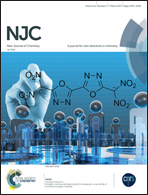Chrysin functionalized NHC–Au(i) complexes: synthesis, characterization and effects on the nematode Caenorhabditis elegans†
Abstract
Following a direct quaternarization protocol, the preparation and full characterization of a series of chrysin derived imidazolium salts (2a–d) are reported. Deprotonation of the latter with potassium hexamethyldisilazide (KHMDS) followed by in situ metalation with AuCl(SMe2) allowed for the synthesis of a series Au(I) imidazol-2-ylidene metal complexes (3a–d) in one step. All metal complexes were properly characterized by means of NMR spectroscopy, FT-IR, and elemental analyses. Crystal structures of complexes 3b and 3c illustrate the metal center geometrical environment and the spatial disposition of the mesityl and chrysin flanking groups in the NHC ligands. We tested if gold(I) complexes 3a–d elicit any biological effect on the nematode Caenorhabditis elegans observing that 3a and 3c inhibited the rate of egg laying, whereas 3b and 3d did not, in contrast 3d reduce body width of the nematode. The imidazolium salts did not show an apparent effect on the anatomy of the worms although 2a reduced the egg-laying rate.



 Please wait while we load your content...
Please wait while we load your content...